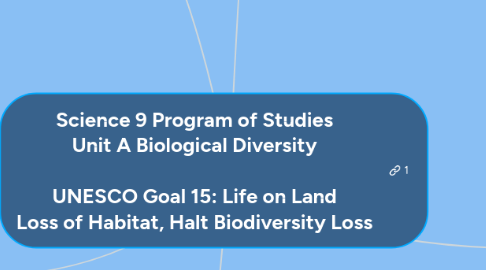
1. Assessment
1.1. Formative Assessment Examples
1.1.1. Observations
1.1.2. Questioning
1.1.2.1. Check & Reflect
1.1.2.2. Socratic method
1.1.3. Discussion
1.1.3.1. Whole-class Q&A
1.1.3.2. Small group Q&A
1.1.3.3. 1-on-1 Conferencing
1.1.4. Self-reflectinon Journals
1.1.5. Peer/Self Assessment
1.1.5.1. SAIL: Strategies for Active and Independent Learning
1.1.6. Diagnostic tests
1.1.7. Pop-quizzes (non-graded)
1.1.8. Entrance/exit slips
1.1.9. Learning/Response logs e-journals
1.1.10. Written questions/exercises
1.1.11. Visual representations
1.1.11.1. Concept maps
1.1.11.2. Visual maps
1.1.11.3. Powerpoint/Prezi
1.1.11.4. Posters
1.1.11.5. Graphic organizer (cartoons)
1.1.12. Think Pair Share
1.1.13. Practice presentations
1.1.14. Digital Forums
1.1.14.1. Padlet
1.1.14.2. Kahoot
1.1.14.3. D2L Blogs
1.2. Summative Assessment
1.2.1. Performance Assessment Task
1.2.1.1. Rubric
2. UN 17 Sustainable Development Goals
2.1. Goal 15: Sustainably manage forests, combat desertification, halt and reverse land degradation, halt biodiversity loss.
2.2. UN 17 Sustainable Development Goals
2.2.1. Students thinking and skills in relation to the intended learning
3. Science 9 Program of Studies
3.1. Unit A Biological Diversity
3.1.1. GLOs
3.1.1.1. GLO 1 Investigate and interpret diversity among species, and describe how contributes to species survival.
3.1.1.2. GLO 4 Identify impacts of human action on species survival and variation within species, and analyze related issues for personal and public decision making.
4. Grizzly Bears
4.1. Habitat
4.1.1. National Parks
4.1.1.1. Banff National Park
4.1.1.1.1. Rocky Mountain Range
4.1.1.1.2. Bow Valley Parkway
4.1.1.1.3. Bow Lake
4.1.1.2. Glacier National Park
4.1.1.2.1. In Canada & USA
4.1.1.3. Yellowstone National Park
4.1.2. Outside of National Parks
4.2. Loss of habitat
4.3. Endangered species
4.4. Extinction
4.5. Extirpation
4.6. Inability to roam freely due to industrial and private development
4.7. Roads, railways and fencing block natural migratory pathways
4.7.1. Ideate: Solutions to this problem
4.7.1.1. Manmade corridors
4.7.1.2. Underground tunnels
4.8. Animal Behaviour & Ecology
4.9. Human-Animal Interaction & Symbiotic interactions
5. Design Thinking Process
5.1. Discovery/Empathy
5.1.1. The students will find deep & meaningful needs through observing and engaging - based on their understanding about loss of habitat and biodiversity. The students will ask questions:
5.1.2. What needs to change & how much? What can change? Who’s Involved? How do they think and why? What do they want and need?
5.1.3. The students will study digital and print maps and research the migratory patterns of bears.
5.1.3.1. Students will research and discover the problems posed by human development to natural migratory paths which prevent bears moving natural from Banff National Park to Glacier National Park.
5.1.4. Students will understand different land title and land rights: Private Land i.e. farms and acreages Crown Land i.e government First Nation Reserves
5.2. Interpretation/Define
5.2.1. The students will reframe needs & insights into actionable problem statements - basing their problems with the basic understanding about the importance of preventing biodiversity loss of grizzly bears and their habitat
5.2.1.1. Defining Problems: Threats to Grizzly Bears Ecology & Wildlife Conservation Habitat Loss Migration & Roaming (Crossing Roads, Railroads, Fences)
5.2.2. The students will analyze what has been learned about the problem, where it takes place & who is involved
5.3. Ideate
5.3.1. Ideation The students will generate volume & variety of ideas by brainstorming individually & collaboratively
5.3.1.1. Problem Solving Students will brainstorm ideas to provide bears with natural migratory paths that enable them to migrate and roam freely between National Parks
5.3.1.2. Students will also brainstorm ideas to prevent the human impact on bears inside and outside of the park boundaries. For example, hunting and trapping
5.3.2. Diverge Ideas
5.3.3. Choose constraints & then remove them to enrich ideas
5.4. Experimentation/Prototype
5.4.1. Converge Ideas
5.4.2. The students will begin to create a prototype of a service, solution or product to protect and conserve the Grizzly Bear population in North America
5.4.3. The students will visualize possible solutions
5.5. Evolution/Test
5.5.1. Students will share prototype with peers, expert and teachers in the school for feedback on how to improve/evolve prototype
5.5.2. Revise/Re-test
